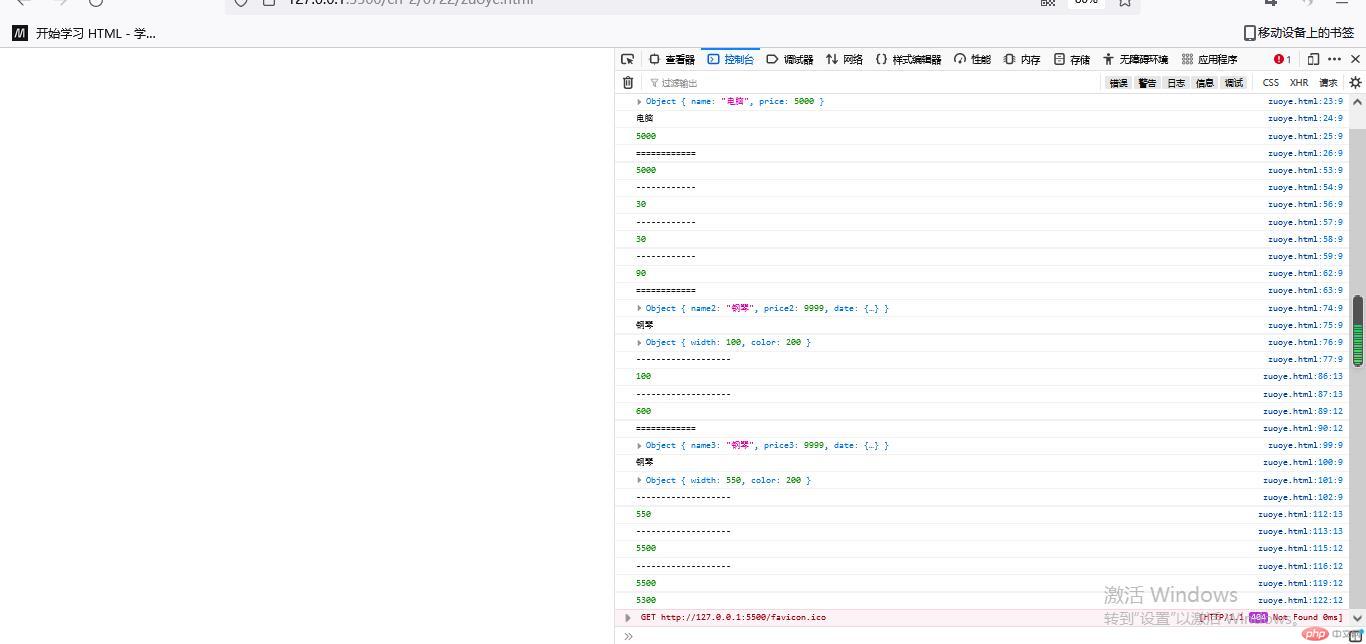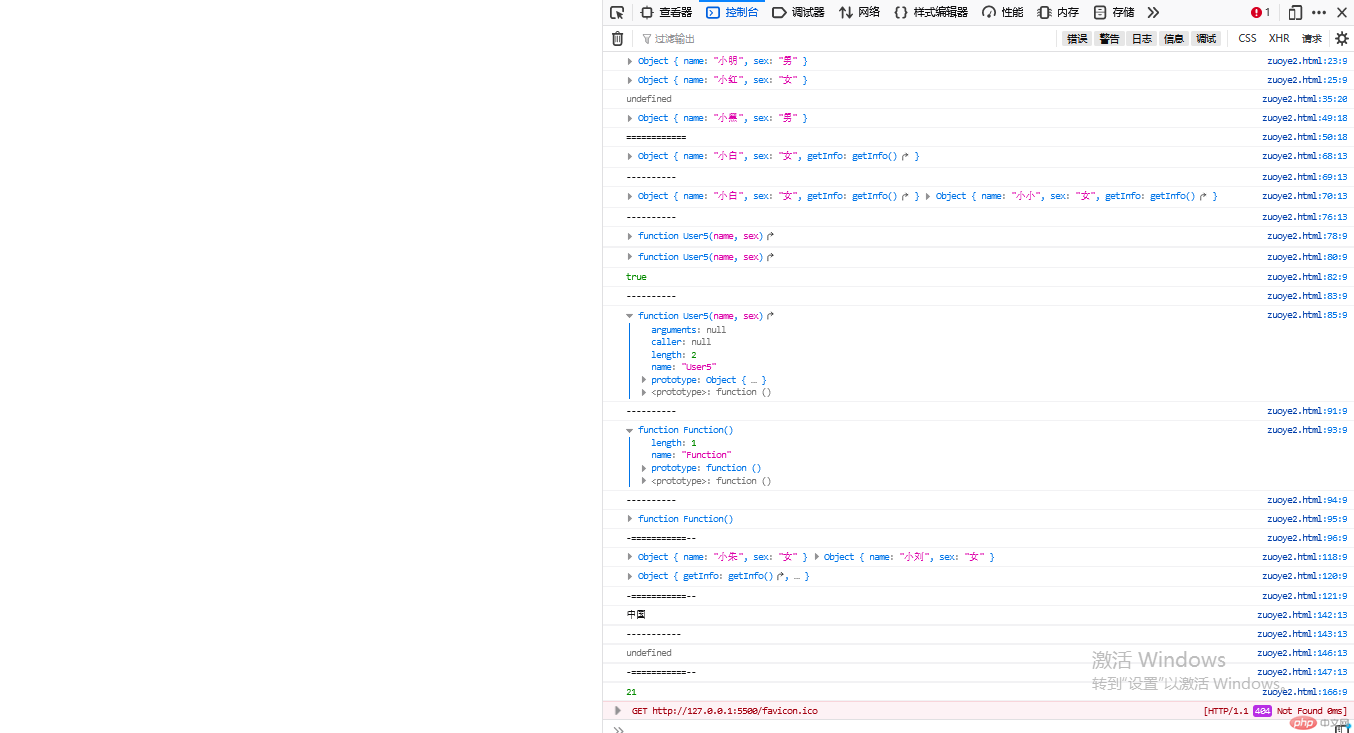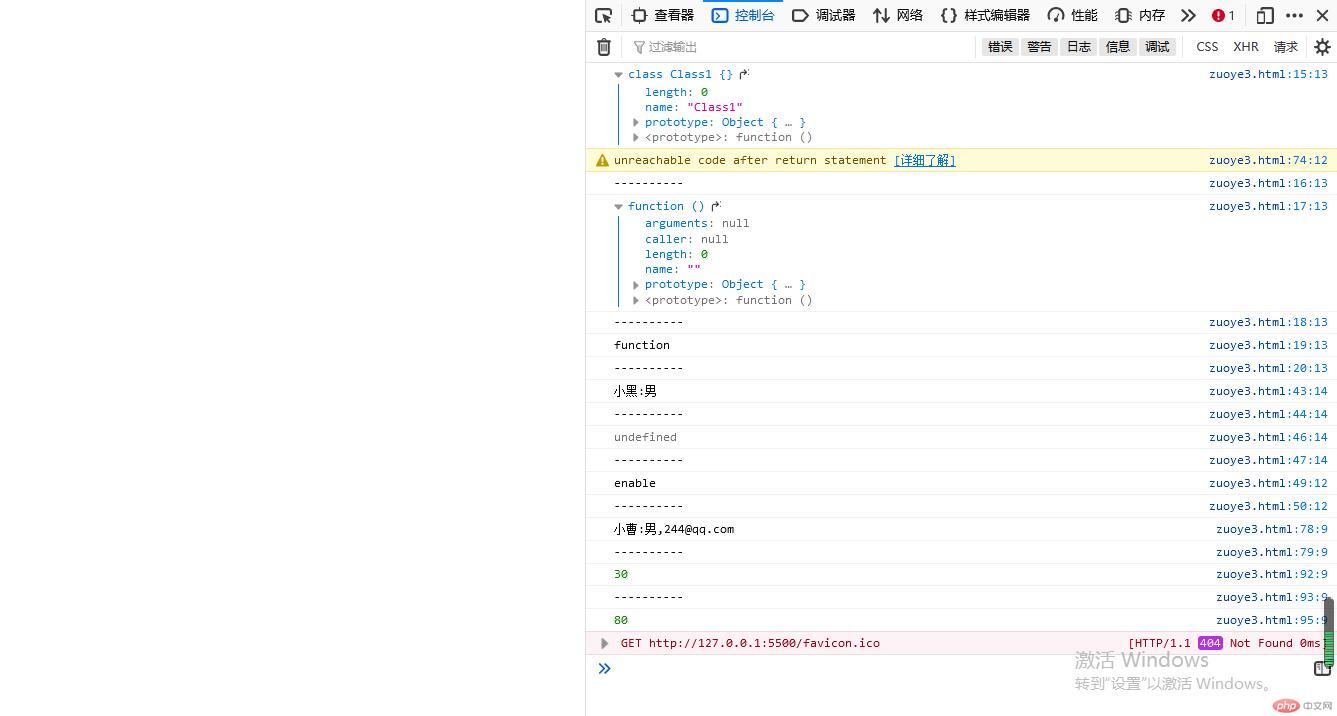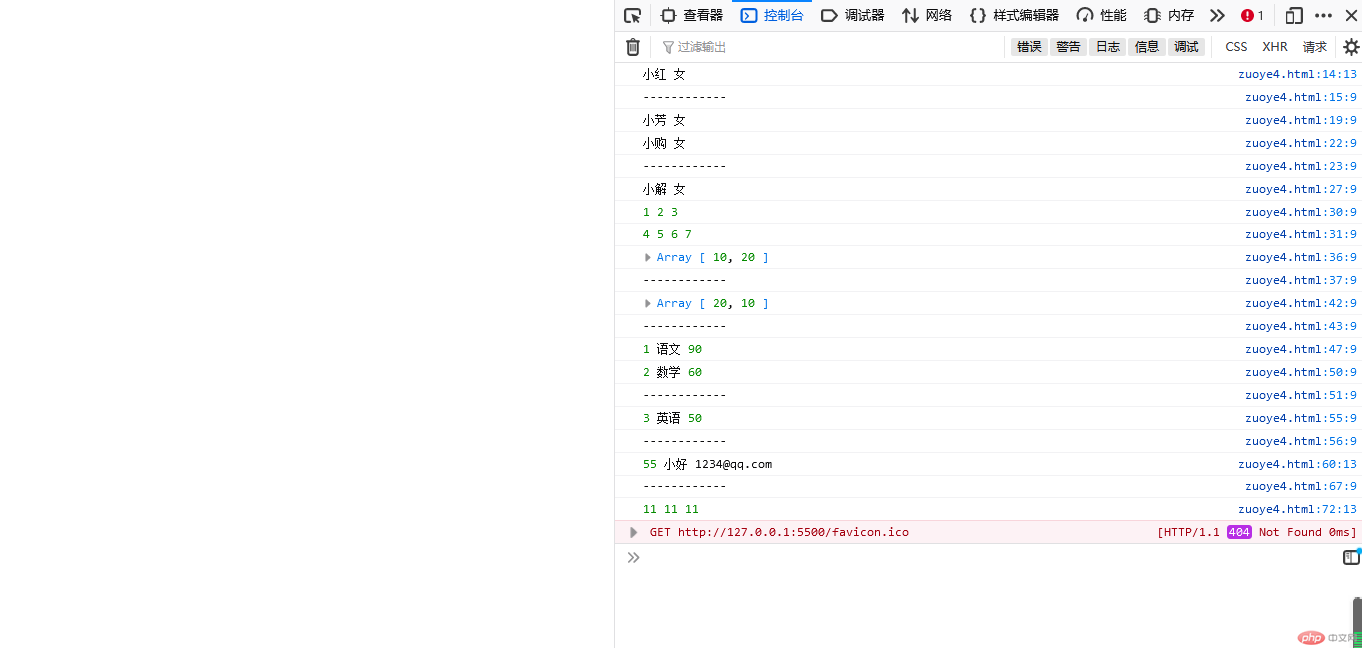批改状态:合格
老师批语:
<!DOCTYPE html><html lang="zh-CN"><head><meta charset="UTF-8"><meta http-equiv="X-UA-Compatible" content="IE=edge"><meta name="viewport" content="width=device-width, initial-scale=1.0"><title>访问器属性</title></head><body><script>// 1、对象字面量// 2、访问接口// 3、接口属性化 -// 对象声明的两种方式// 1、一次性添加let item = {date : {name :'电脑',price :5000,}}console.log(item);console.log(item.date);console.log(item.date.name);console.log(item.date.price);console.log('============');// 为属性 data price 设置访问接口// 接口就是 方法 函数// 数据 只有两种访问方式:读取、写入let item1 = {date1 : {name1 :'电脑',price1 :5000,},// 读取操作getPrice () {return item1.date1.price1;},// 写操作,一定要传参setPrice(value){this.date1.price1 = value;},}// 注意方法后面要跟括弧、// 给大家拓展个小技巧,括号我是这么记得:// 首先是中括号[]:这玩意儿绝大多数情况下都是用来包裹数组的。// 然后是大括号{}:这玩意儿绝大多数是用来包裹代码段(块)和对象// 的,比如自己写的函数的代码逻辑部分就得在大括号里。// 最后是小括号():这玩意儿绝大多数是用来跟函数打交道的。比如说调用// 函数后面得跟它,自己写的函数,函数的参数得传在小// 括号里。还有一部分情况是需要让编程语言将一段代码// 看做一个整体,需要用小括号包裹起来。console.log(item1.getPrice());console.log('------------');item1.date1.price1 = 30;console.log(item1.getPrice());console.log('------------');console.log(item1.date1.price1);console.log('------------');// 用 price1的访问接口item1.setPrice(90);console.log(item1.getPrice());console.log('============');// 2、逐个追加// 先创建一个空对象(理论上的)let item2 = { };item2.name2 = '钢琴';item2.price2 =9999;item2.date ={};item2.date.width = 100;item2.date.color = 200;console.log(item2);console.log(item2.name2);console.log(item2.date);console.log('-------------------');// 读取操作item2.getPrice = function (){return item2.date.width;};// 写操作,一定要传参item2.setPrice = function(value){this.date.width = value ;};console.log(item2.getPrice());console.log('-------------------');item2.setPrice(600);console.log(item2.getPrice());console.log('============');// 采用接口数据验证let item3 = { };item3.name3 = '钢琴';item3.price3 =9999;item3.date ={};item3.date.width = 550;item3.date.color = 200;console.log(item3);console.log(item3.name3);console.log(item3.date);console.log('-------------------');// 读取操作item3.getPrice = function (){return item3.date.width;};// 写操作,一定要传参item3.setPrice = function(value){if(value < 4000) return false;this.date.width = value ;};console.log(item3.getPrice());console.log('-------------------');item3.setPrice(5500);console.log(item3.getPrice());console.log('-------------------');// 价格小于4000失效item3.setPrice(2000);console.log(item3.getPrice());// 价格大于4000生效item3.setPrice(5300);console.log(item3.getPrice());// 简化版 模板字面量// 注意反引号、console.log(`${item3.date.width} : ${item3.date.color} `);console.log('--********--');// 再次简化 : 接口属性化let item4 = {date4 :{name4:'苹果',price4:30,},// price 属性的访问接口 属性为 访问器属性。看着get price4() {return this.date4.price4;},set price4(value) {this.date4.price4 = value;},// 经过以上操作,访问接口全部属性化了// 这是访问器属性,实际上是方法,只不过伪装成了属性。套用一个属性的马甲};// 访问器属性:属性二字,表明了该方法的使用方式console.log(item4.price4);console.log(`${item4.price4} `);</script></body></html>

<!DOCTYPE html><html lang="zh-CN"><head><meta charset="UTF-8"><meta http-equiv="X-UA-Compatible" content="IE=edge"><meta name="viewport" content="width=device-width, initial-scale=1.0"><title>构造函数、面向对象特征</title></head><body><script>// 函数:创建一个对象let User1 =function (name ,sex) {// 步骤 三步// 1步骤一:创建空对象 保存结果let obj = {};// 2、为这个新对象,添加属性和方法obj.name = name;obj.sex = sex ;// 3、返回这个新对象return obj ;};let user1 = User1('小明','男');console.log(user1);let user2= User1('小红','女');console.log(user2);// 构造函数:专用来创建对象的函数 以下// 可以用来简化,直接this 引用 这个新对象let User2 =function (name ,sex) {this.name = name;this.sex = sex ;};let user3 = User2('小黑','男')console.log(user3);// 此时 this的 指向有问题 没有指向对象,而是指向全局了 Window this指向有问题需要修正// 以上// 构造函数:专用来创建对象的函数 以下// 可以用来简化,直接this 引用 这个新对象let User3 =function (name ,sex) {this.name = name;this.sex = sex ;};// new 可以修正 构造函数内部 this的指向。指向新的对象,而非Window// 因此构造函数必须 是用new 调用let user4 = new User2('小黑','男')console.log(user4);console.log('============');// 此时 this的 没有有问题 修正后// 以上// 构造函数: 创建对象(实例) ,通常对象和实例是同义// 构造函数 必须使用new调用let User5 = function (name , sex ){// 属性this.name =name;this.sex = sex;// 方法this.getInfo =function() {// 模板字面量,注意反引号,注意大括号return `${this.name}:${this.sex}`;};};let user5 = new User5 ('小白','女');let user6= new User5 ('小小','女');console.log(user5);console.log('----------');console.log(user5,user6);// 此时两个对象user5和 user6属性不同,是正确的,但是方法一样,出现代码冗余,需要简化// 多余的方法,实际上应该是被所有实例所共享,只需要保留一个方法即可// 不需要为每个对象保留一遍方法的代码// 其中prototypeconsole.log('----------');// 查看对象的构造器,查本溯源console.log(user5.constructor);// 查看构造函数console.log(User5);// 对象的构造器等于 构造函数、、console.log(user5.constructor == User5);console.log('----------');// 自动打开console.dir(User5);// 所有函数都有一个prototype// 这个原型属性对普通函数,没有用、、// 但是对于构造函数,有用、// 构造函数原型属性的成员,,可以被该该构造函数所有实例共享console.log('----------');// 自己指向了自己console.dir(User5.constructor);console.log('----------');console.log(User5.constructor);console.log('-===========--');let User6 = function (name , sex ){// 属性// 自有属性this.name =name;this.sex = sex;// 方法 放在这儿会被每个对象生成一个副本,因此放到公共位置// this.getInfo =function() {// // 模板字面量,注意反引号,注意大括号// return `${this.name}:${this.sex}`;// };};// 将对象的共享成员,挂载到构造器的原型属性prototype上// 共享属性User6.prototype.getInfo = function (){// 模板字面量return `${this.name}:${this.sex}`;};let user7 = new User6 ('小朱','女');let user8= new User6 ('小刘','女');// 不会展示原型属性console.log(user7,user8);// 查看原型属性console.log(User6.prototype);console.log('-===========--');// 共享成员:加到原型属性// 1、自有成员 直接在方法 this.xxx// 2、共享成员,构造器的原型属性 fun.prototype// 3、私有成员 let// 4、静态成员 static 当前构造函数使用static// 5、继承let User7 = function (name , sex ){// 私有成员let email = '1123@qq.com';// 属性// 自有属性this.name =name;this.sex = sex;};// 静态成员: 只能用构造函数 自身防伪,不能用实例访问// 只属于 构造函数。不属于 实例对象, 只能有类访问// 函数也是对象,是对象就可以为他添加属性User7.nation = '中国';console.log(User7.nation);console.log('-----------');let y = new User7('a','b');// 访问不到 nationconsole.log(y.nation);console.log('-===========--');// 继承// jS没有类的概念 基于原型来实现继承// 父级为构造函数let Parent = function() {};// 方法公共的Parent.prototype.sum = function(){return this.a +this.b;};// 子类构造器,构造函数、、let Child = function (a,b) {this.a =a;this.b =b ;}// 子类继承父类的原型方法Child.prototype = Parent.prototype;let child = new Child (1,20);console.log(child.sum());</script></body></html>

<!DOCTYPE html><html lang="zh-CN"><head><meta charset="UTF-8"><meta http-equiv="X-UA-Compatible" content="IE=edge"><meta name="viewport" content="width=device-width, initial-scale=1.0"><title>class类简化构造函数创建对象的过程</title></head><body><script>// 类?// 其实js没有类 ,js中的类就是函数// 声明类 ,空类class Class1 {};console.dir(Class1);console.log('----------');console.dir(function(){});console.log('----------');console.log(typeof Class1);console.log('----------');// es6 class// class 声明类class Demo1 {// 构造方法,实例初始化// 注意构造方法后面 不要有分号constructor(name ,sex) {// 自有属性this.name= name;this.sex = sex;// 注意构造方法后面 不要有分号}// 共享、原型成员 声明在原型里面// 注意构造方法后面 不要有分号getInfo() {// 模板字面量return `${this.name}:${this.sex} `;}// 静态成员static status = 'enable';};const obj = new Demo1 (`小黑`,'男');console.log(obj.getInfo());console.log('----------');// 访问不到 静态成员要以构造函数访问console.log(obj.status);console.log('----------');// 访问到了console.log(Demo1.status);console.log('----------');// 继承 extends Demo2 也是类class Demo2 extends Demo1 {// 子类 构造器 写的方法一// 注意构造方法后面 不要有分号// constructor(name ,sex) {// 自有属性// this.name= name;// this.sex = sex;// 注意构造方法后面 不要有分号// }// 子类 构造器 写的方法二// super()会自动 调用父类的构造器初始化该实例constructor(name ,sex,email) {super(name,sex);// 子类自有属性 子类属性初始化this.email =email;}// 子类对父类方法初始化和扩展getInfo() {// 模板字面量 写法一// 反引号中不能有中文return `${this.name}:${this.sex},${this.email} `;// 简写return `${super.getInfo()}+${this.email} `;}}const obj2 = new Demo2('小曹','男','244@qq.com');console.log(obj2.getInfo());console.log('----------');// 在类中可以使用访问器属性class Demo3 {age = 30;get age(){return this.age;}set age(value){this.age =value;}}// 访问器属性实现const obj4 = new Demo3 ();console.log(obj4.age);console.log('----------');obj4.age = 80;console.log(obj4.age);</script></body></html>

<!DOCTYPE html><html lang="zh-CN"><head><meta charset="UTF-8"><meta http-equiv="X-UA-Compatible" content="IE=edge"><meta name="viewport" content="width=device-width, initial-scale=1.0"><title>解构赋值</title></head><body><script>const user = ['小红','女'];let username = user[0];let username1 = user[1]console.log(username ,username1);console.log('------------');// 1、数字解构// 更新[username ,username1] = ['小芳','女'];console.log(username ,username1);// 初始化let [username2 ,username3] = ['小购','女'];console.log(username2 ,username3);console.log('------------');// 参数不足:默认值上// 模板中有三个变量,但是值只有两个 不足,只展示两个[username ,username1,age] = ['小解','女'];console.log(username ,username1);// 参数过多[a,b,c,...arr] = [1,2,3,4,5,6,7];console.log(a,b,c);console.log(...arr);// 二次交换let x =10;let y =20;console.log([x,y]);console.log('------------');// let z = x;// let x = y ;// let y = z;[y,x] = [x,y];console.log([x,y]);console.log('------------');// 对象解构// 目标是吧对象中的属性值保存到对应的,与属性同名的变量中let {id , lesson ,price} = {id :1, lesson :'语文',price:90};console.log(id, lesson,price );// 更新 必须转为表达式 小括号 把整个表达式封装起来({id , lesson ,price} = {id :2, lesson :'数学',price:60});console.log(id, lesson,price );console.log('------------');// 如果左边模板中的变量存在命名冲突,需要起一个别名let {id:item , num ,score} = {id :3, num :'英语',score:50};console.log(item,num,score);console.log('------------');// 应用场景function getUser(user123){// user123 是一个对象console.log(user123.id11, user123.name11, user123.email11);}// 方法一let user123 = { id11:55, name11:'小好',email11:'1234@qq.com'}// 方法一 调用getUser(user123);console.log('------------');let user456 = {id1234:11, name1234:11,email1234:11};function getUser2({id1234, name1234,email1234}){// user456 是一个对象console.log(id1234, name1234,email1234);}// 方法一 调用getUser2(user456);</script></body></html>


Copyright 2014-2025 https://www.php.cn/ All Rights Reserved | php.cn | 湘ICP备2023035733号